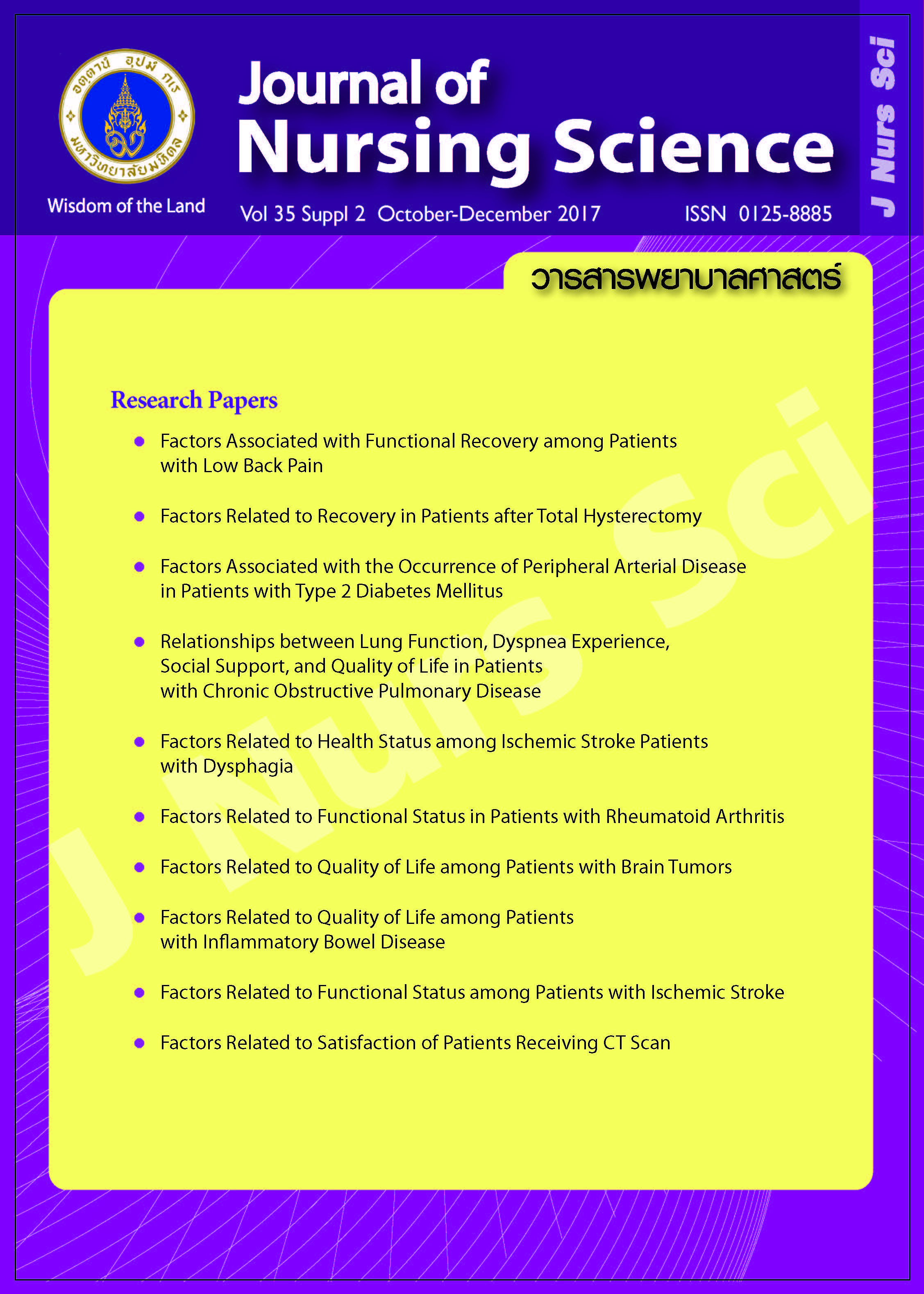Factors Related to Recovery in Patients after Total Hysterectomy ปัจจัยที่มีความสัมพันธ์กับการฟื้นตัวของผู้ป่วยหลังผ่าตัดเอามดลูกออกทั้งหมด
Main Article Content
Abstract
Purpose: To identify factors related to recovery among patients after total hysterectomy.
Design: Descriptive correlational design.
Methods: The sample composed of 115 adult patients after total hysterectomy at Bach Mai Hospital and the National Hospital of Obstetrics & Gynecology, Hanoi, Viet Nam. Data were collected using the patients’ medical record and interviewed with 3 questionnaires: 1) the Numerical Rating Scale, 2) the Multidimensional Scale of Perceived Social Support, and 3) the Quality of Recovery-15. Spearman’s Rho was employed to test correlation among studied variables.
Main findings: The findings revealed that pain score was negatively related to recovery (rs = - .70, p < .05); while co-morbidity and social support were not related to recovery (p > .05).
Conclusions and recommendations: Pain was the vital factor inhibiting patients’ recovery. Therefore, in order to promote the patients’ smooth transition to their optimum recovery, pain should be well controlled. Pain management protocol should be developed and tested for their effectiveness through research before implementation.
บทคัดย่อ
วัตถุประสงค์: เพื่อศึกษาปัจจัยที่มีความสัมพันธ์กับการฟื้นตัวของผู้ป่วยหลังผ่าตัดเอามดลูกออกทั้งหมด
รูปแบบการวิจัย: การวิจัยเชิงสหสัมพันธ์
วิธีดำเนินการวิจัย: กลุ่มตัวอย่างเป็นผู้ป่วยภายหลังการผ่าตัดเอามดลูกออกทั้งหมดจำนวน 115 คน ที่รับการรักษาที่หอผู้ป่วยหลังผ่าตัด โรงพยาบาลบัคมาย และโรงพยาบาลสูตินรีเวช กรุงฮานอย ประเทศเวียดนาม เก็บข้อมูลด้วยการสัมภาษณ์โดยใช้แบบสอบถาม และเก็บข้อมูลบางส่วนจากแฟ้มประวัติของกลุ่มตัวอย่าง วิเคราะห์ความสัมพันธ์ของตัวแปรโดยใช้สถิติสเปียร์แมนโรว์
ผลการวิจัย: ผลการศึกษาพบว่า ความปวดมีความสัมพันธ์ทางลบกับการฟื้นตัวของผู้ป่วยหลังผ่าตัดเอามดลูกออกทั้งหมด (rs = - .70, p < .05) อย่างไรก็ตาม การมีโรคร่วมและการสนับสนุนทางสังคมไม่มีความสัมพันธ์กับการฟื้นตัวหลังการผ่าตัดเอามดลูกออกทั้งหมด
สรุปและข้อเสนอแนะ: เนื่องจากความปวดหลังผ่าตัดเป็นปัจจัยสำคัญที่ขัดขวางการฟื้นตัว ดังนั้นเพื่อส่งเสริมให้ผู้ป่วยเกิดการเปลี่ยนผ่านอย่างราบรื่นจนเกิดการฟื้นตัวได้อย่างเต็มที่ ผู้ป่วยควรได้รับการควบคุมความปวดอย่างมีประสิทธิภาพหลังการผ่าตัด และควรมีการพัฒนาแนวปฏิบัติเพื่อควบคุมความปวด และนำไปทดสอบประสิทธิผลด้วยงานวิจัยก่อนนำไปใช้
Article Details
Copyright Notice: Nursing Science Journal of Thailand has exclusive rights to publish and distribute the manuscript and all contents therein. Without the journal’s permission, the dissemination of the manuscript in another journal or online, and the reproduction of the manuscript for non-educational purpose are prohibited.

Disclaimer: The opinion expressed and figures provided in this journal, NSJT, are the sole responsibility of the authors. The editorial board bears no responsibility in this regard.
References
2. Azari L, Santoso JT, Osborne SE. Optimal pain management in total abdominal hysterectomy. Obstet Gynecol Surv. 2013;68(3):215-27.
3. Altman D, Granath F, Cnattingius S, Falconer C. Hysterectomy and risk of stress-urinary-incontinence surgery: nationwide cohort study. Lancet. 2007;370(9597):1494-9.
4. Yakasai I. Complications of Hysterectomy: a review. British Journal of Science. 2013;9(2):78-87.
5. Gupta S, Manyonda I. Hysterectomy for benign gynecological disease. Obstet Gyneacol Reprod Med. 2014;24(5):135–40.
6. Rahman K. Studies on free radicals, antioxidants, and co-factors. Clin Interv Aging. 2007;2(2):219–36.
7. Xiromeritis P, Kalogiannidis I, Papadopoulos E, Prapas N, Prapas Y. Improved recovery using multimodal perioperative analgesia in minimally invasive myomectomy: a randomized study. Aust N Z J Obstet Gynaecol. 2011;51(4):301–6.
8. Theunissen M, Peters ML, Schepers J, Maas JW, Tournois F, van Suijlekom HA, et al. Recovery 3 and 12 months after hysterectomy: epidemiology and predictors of chronic pain, physical functioning, and global surgical recovery. Medicine (Baltimore). 2016; 95(26):e3980. doi: 10.1097/MD.0000000000003980.
9. Nicholas Z, Hu N, Ying J, Soisson P, Dodson M, Gaffney DK. Impact of comorbidity conditions on survival in endometrial cancer. Am J Clin Oncol. 2014;37(2):131-4.
10. Mitchison AR, Kim HM, Geisser M, Rosenberg JM, Hinshaw DB. Social connectedness and pain recovery after major operations. J Am Coll Surg. 2008;206(2):292–300.
11. Meleis AI, Sawyer LM, Im EO, Hilfinger Messias DK, Schumacher K. Experiencing transitions: an emerging middle-range theory. ANS Adv Nurs Sci. 2000;23(1):12-28.
12. Faul F, Erdfelder E, Buchner A, Lang AG. Statistical power analyses using G*Power 3.1: tests for correlation and regression analyses. Behav Res Methods. 2009;41(4):1149-60.
13. Cohen J. A power primer. Psychol Bull. 1992;112(1):155-9.
14. McCaffery M, Beebe A. Pain: clinical manual for nursing practice. St. Louis: Mosby, MO; 1989.
15. Koneti KK, Jones M. Management of acute pain. Surgery. 2016;34(2):84-90.
16. Zimet GD, Dahlem NW, Zimet SG, Farley GK. The Multidimensional scale of perceived social support. J Pers Assess. 1988;52(1):30-41.
17. Stark PA, Myles SP, Burke AJ. Development and psychometric evaluation of a postoperative quality of recovery score: the QoR-15. Anesthesiology. 2013;118(6):1332-40.
18. Nelson G, Altman AD, Nick A, Meyer LA, Ramirez PT, Achtari C, et al. Guidelines for postoperative care in gynecologic/oncology surgery: Enhanced Recovery After Surgery (ERAS) society recommendations--Part II. Gynecol Oncol. 2016;140(2):323-32.
19. Parker MC, Ellis H, Moran BJ, Thompson JN, Wilson MS, Menzies D, et al. Postoperative adhesions: ten-year follow-up of 12,584 patients undergoing lower abdominal surgery. Dis Colon Rectum. 2001;44(6):822-9.
20. Goktas SB, Gun I, Yildiz T, Sakar MN, Caglayan S. The effect of total hysterectomy on sexual function and depression. Pak J Med Sci. 2015;31(3):700-5.
21. Clayton M. Verow P. A retrospective study of return to work following surgery. Occup Med (Lond). 2007;57(7):525–31.
22. Gögenur I. Postoperative circadian disturbances. Dan Med Bull. 2010;57(12):B4205.
23. Vousoura E, Spyropoulou AC, Koundi KL, Tzavara C, Verdel H, Paparrigopoulos T, et al. Vasomotor and depression symptoms may be associated with different sleep disturbance patterns in postmenopausal women. Menopause. 2015;22(10):1053-7.
24. Sivrikaya GU. Multimodal analgesia for postoperative pain management. In: Gabor B. Racz GB, Noe CE, editors. Pain management - current issues and opinions. Europe: InTech; 2012. p.197-210.
25. Corke P. Postoperative pain management. Aust Prescr. 2013;36(6):202–5.


